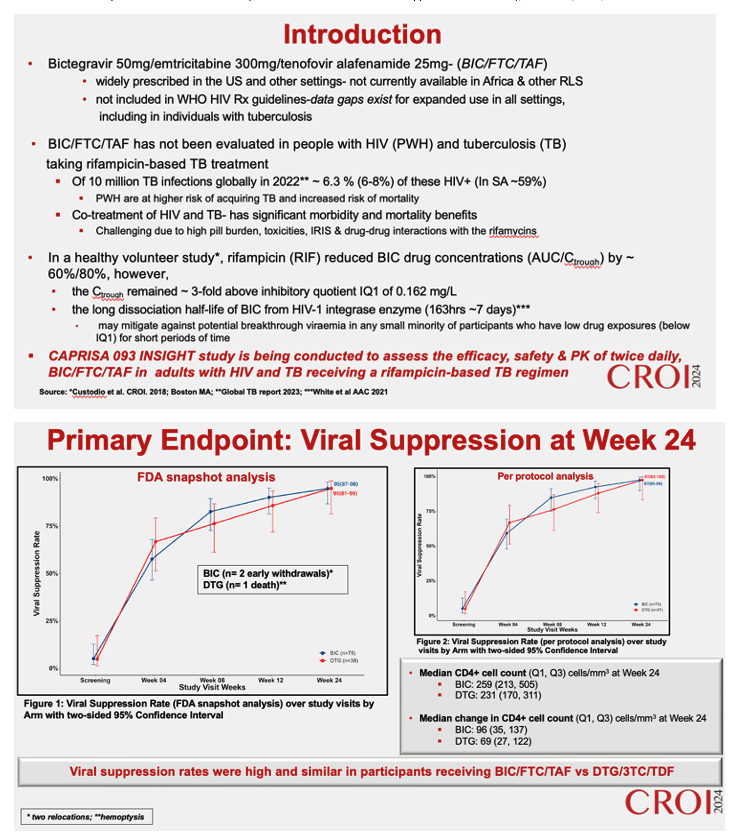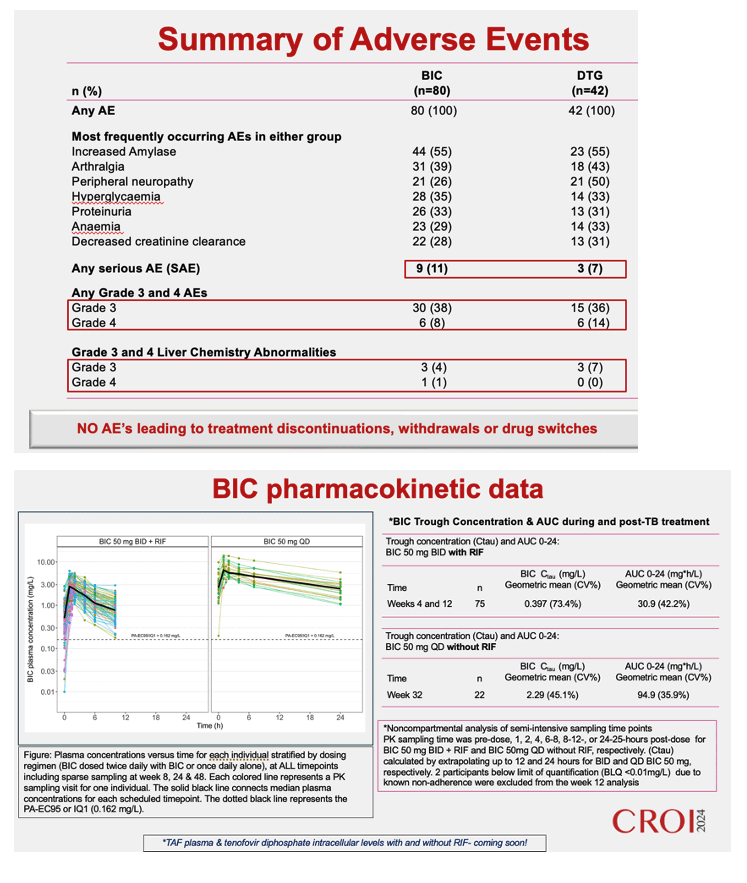 |
 |
 |
| |
Twice-Daily BIC/FTC/TAF With Rifampicin Effective in People With HIV and TB
|
| |
| |
CROI 2024 (Conference on Retroviruses and Opportunistic Infections), March 3-6, 2024, Denver
Mark Mascolini
Twice-a-day bictegravir/emtricitabine/tenofovir alafenamide (BIC/FTC/TAF), given with rifampicin to people with HIV and tuberculosis, pushed HIV loads below 50 copies in 95% randomized to this regimen [1]. CAPRISA 093 INSIGHT study investigators found the same virologic result with dolutegravir/tenofovir disoproxil/lamivudine (DTG/TDF/3TC), plus an extra nightly dose of DTG, in this 122-person trial.
Widely used in the US and Europe, BIC/FTC/TAF is not available in Africa and other resource-limited countries and gets left off the WHO list of recommended regimens. An estimated 6% of people with TB also have HIV infection, and coexistence of the two infections results in higher mortality, the CAPRISA team noted. Treating HIV and TB together yields clear benefits in morbidity and mortality, but simultaneous treatment of the two infections is challenging because of high pill burden, toxicity, immune reconstitution inflammatory syndrome (IRIS), and potential drug-drug interactions with rifampicin. In healthy volunteers, coadministration of rifampicin lowered BIC trough concentrations 60% to 80%, but BIC troughs remained about 3-fold higher than the inhibitory quotient of 0.162 mg/L.
The South African CAPRISA 093 INSIGHT trial recruited adults with HIV and confirmed rifampicin-susceptible TB or taking their first rifampicin regimen for 8 or fewer weeks. Participants could have no antiretroviral experience or no antiretroviral use within 3 months of enrollment. CD4 count had to be above 50 and estimated glomerular filtration rate above 60 mL/min.
Researchers randomized 122 people in a 2-to-1 ratio to twice-daily BIC/FTC/TAF or once-daily DTG/TDF/3TC plus a nightly 50-mg dose of DTG. Two weeks after rifampicin stopped, dosing switched to once-daily BIC/FTC/TAF and DTG/TDF/FTC. The primary endpoint was an HIV load below 50 copies at week 24 in the BIC arm by FDA snapshot analysis.
The 80 people randomized to BIC and the 42 randomized to DTG both had a median age of 35, and all were black. In the BIC and DTG arms, 31% and 43% were female, median viral load stood at 75,649 and 73,735 copies, and CD4 count at 172 and 139. Median time from starting TB therapy to randomization measured 15 and 16 days. Respective proportions who had taken antiretrovirals were 29% and 38%.
Week-24 FDA snapshot analysis determined that 95% randomized to either BIC or DTG had a viral load below 50 copies. The BIC group had 2 early withdrawals due to relocation, and 1 person randomized to DTG died with hemoptysis. In a per-protocol analysis, 97% randomized to either treatment arm had a 24-week viral load below 50 copies. Median CD4-cell gains through 24 weeks measured 96 with BIC and 69 with DTG.
Nine people (11%) randomized to BIC and 3 (7%) randomized to DTG had any serious adverse event. Respective numbers (and percents) with any grade 3 event were 30 (38%) and 15 (36%) and with any grade 4 event 6 (8%) and 6 (14%). No adverse events led participants to stop treatment, switch drugs, or withdraw from the trial.
Geometric mean BIC trough concentration at a dose of 50 mg twice daily with rifampicin during weeks 4 to 12 stood at 0.397 mg/L (coefficient of variation [CV] 73.4%). At a dose of 50 mg once daily at week 32 without rifampicin, BIC geometric mean trough measured 2.29 mg/L (CV 45.1%).
The CAPRISA 093 investigators proposed that their findings support use of BIC/FTC/TAF in people with HIV and TB and "may open a pathway for inclusion in WHO guidelines and access in TB-endemic settings."
Reference
1. Naidoo A, Naidoo K, Letsoalo MP, et al. INSTIs for the management of HIV-associated TB (INSIGHT Study): efficacy, safety and PK of BIC/FTC/TAF in adults with HIV and tuberculosis on rifampicin at week 24. CROI 2024 (Conference on Retroviruses and Opportunistic Infections), March 3-6, 2024, Denver. Abstract 211.


|
| |
|
 |
 |
|
|